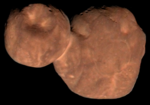L 98-59 b
 Artist's impression and size comparison with Earth and Mars | |
| Discovery[1] | |
|---|---|
| Discovery date | March 2019 |
| Transit | |
| Orbital characteristics[2] | |
| 0.02191+0.00080 −0.00084 AU | |
| Eccentricity | 0.103+0.117 −0.045 |
| 2.2531136+0.0000012 −0.0000015 d | |
| Inclination | 87.71°+1.16° −0.44° |
| Semi-amplitude | 0.56±0.16 m/s[3] |
| Star | L 98-59 |
| Physical characteristics[2] | |
| 0.850+0.061 −0.047 R🜨 | |
| Mass | 0.47+0.13 −0.15 M🜨[3] |
Mean density | 4.3+1.2 −1.9 g/cm3[3] |
| Temperature | 627+33 −36 K (354 °C; 669 °F, equilibrium) |
L 98-59 b is an exoplanet having a size between that of the Earth and Mars and a mass only half that of Venus.[2] It orbits L 98-59, a red dwarf star 34.6 light-years away in the constellation Volans. There are at least 3 (possibly 4) other planets in the system: L 98-59 c, d, e, and the unconfirmed L 98-59 f.[2] Its discovery was announced on 27 June 2019 in The Astronomical Journal[1] and in a NASA press release. It was the smallest planet discovered by TESS[4] until the discovery of LHS 1678 b,[5] and was the lowest-mass planet whose mass had been measured using radial velocities[2] until Proxima Centauri d was found in 2022.[6]
Characteristics
L 98-59 b orbits its star in 2.25 days and stays so close to the star that it receives 22 times more energy than Earth receives from the Sun. There are 4 confirmed planets in the system but they are not in the habitable zone of the host star.[4] The temperature of the planet detected by TESS is 330 °C.[7] In 2022, transmission spectroscopy indicated that the planet has either no atmosphere or an opaque atmosphere with high-altitude hazes.[8]
Transmission spectroscopy observations with the James Webb Space Telescope NIRSpec published in 2025 favor the presence of a sulfur dioxide atmosphere. This is likely driven by volcanism, implying that L 98-59 b experiences at least eight times as much volcanism and tidal heating as Io.[9]
References
- ^ a b Kostov, Veselin B.; Schlieder, Joshua E.; et al. (July 2019). "The L 98-59 System: Three Transiting, Terrestrial-size Planets Orbiting a Nearby M Dwarf". The Astronomical Journal. 158 (1): 32. arXiv:1903.08017. Bibcode:2019AJ....158...32K. doi:10.3847/1538-3881/ab2459.
- ^ a b c d e Demangeon, Oliver D. S.; Zapatero Osorio, M. R.; Alibert, Y.; Barros, S. C. C.; Adibekyan, V.; Tabernero, H. M.; et al. (July 2021). "A warm terrestrial planet with half the mass of Venus transiting a nearby star" (PDF). Astronomy & Astrophysics. 653: 38. arXiv:2108.03323. Bibcode:2021A&A...653A..41D. doi:10.1051/0004-6361/202140728. S2CID 236957385.
- ^ a b c Rajpaul, Vinesh M.; Barragán, Oscar; Zicher, Norbert (June 2024). "A non-zero Doppler amplitude is not enough: revisiting the putative radial velocity detection of sub-Venus exoplanet L 98-59b". Monthly Notices of the Royal Astronomical Society. 530 (4): 4665–4675. Bibcode:2024MNRAS.530.4665R. doi:10.1093/mnras/stae778.
- ^ a b Garner, Rob (2019-06-24). "NASA's TESS Mission Finds Its Smallest Planet Yet". NASA. Retrieved 2019-06-29.
- ^ Silverstein, Michele L.; Schlieder, Joshua E.; Barclay, Thomas; Hord, Benjamin J.; Jao, Wei-Chun; Vrijmoet, Eliot Halley; Henry, Todd J.; Cloutier, Ryan; Kostov, Veselin B.; Kruse, Ethan; Winters, Jennifer G.; Irwin, Jonathan M.; Kane, Stephen R.; Stassun, Keivan G.; Huang, Chelsea (2022-04-01). "The LHS 1678 System: Two Earth-Sized Transiting Planets and an Astrometric Companion Orbiting an M Dwarf Near the Convective Boundary at 20 pc". The Astronomical Journal. 163 (4): 151. arXiv:2110.12079. Bibcode:2022AJ....163..151S. doi:10.3847/1538-3881/ac32e3. ISSN 0004-6256. S2CID 239768873.
- ^ Faria, J. P.; Suárez Mascareño, A.; et al. (January 4, 2022). "A candidate short-period sub-Earth orbiting Proxima Centauri" (PDF). Astronomy & Astrophysics. 658. European Southern Observatory: 17. arXiv:2202.05188. Bibcode:2022A&A...658A.115F. doi:10.1051/0004-6361/202142337.
- ^ "Canicule ? Il fait 330 degrés sur la petite exoplanète découverte par le télescope spatial TESS". Numerama (in French). 2019-07-01. Retrieved 2019-07-30.
- ^ Damiano, Mario; Hu, Renyu; Barclay, Thomas; Zieba, Sebastian; Kreidberg, Laura; Brande, Jonathan; Colon, Knicole D.; Covone, Giovanni; Crossfield, Ian; Domagal-Goldman, Shawn D.; Fauchez, Thomas J.; Fiscale, Stefano; Gallo, Francesco; Gilbert, Emily; Hedges, Christina L.; Kite, Edwin S.; Kopparapu, Ravi K.; Kostov, Veselin B.; Morley, Caroline; Mullally, Susan E.; Pidhorodetska, Daria; Schlieder, Joshua E.; Quintana, Elisa V. (2022), "A Transmission Spectrum of the Sub-Earth Planet L98-59 b in 1.1–1.7 μm", The Astronomical Journal, 164 (5): 225, arXiv:2210.10008, Bibcode:2022AJ....164..225D, doi:10.3847/1538-3881/ac9472, S2CID 252968265
- ^ Bello-Arufe, Aaron; Damiano, Mario; et al. (January 2025). "Evidence for a volcanic atmosphere on the sub-Earth L98-59b". The Astrophysical Journal Letters. arXiv:2501.18680.



